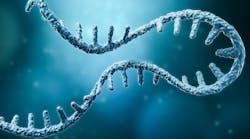In the 1950s, thalidomide was introduced as a sedative and quickly became popular for treating morning sickness in pregnant women. However, its widespread use was then linked to severe birth defects in thousands of babies, prompting its withdrawal from the market in the early 1960s.
While the tragedy significantly impacted drug regulation and safety protocols worldwide, in the decades that followed, thalidomide found a remarkable second life in medicine.
Research uncovered its effectiveness in treating conditions like leprosy and multiple myeloma, due to its anti-inflammatory and anti-angiogenic properties, and it was discovered that the drug belonged to a special new class of therapeutics: molecular glue degraders.
This revelation, centered around thalidomide's interaction with cereblon and other target proteins, catalyzed the exploration of similar molecules for targeted protein degradation. Since then, advances in the understanding of protein-protein interactions and the ubiquitin-proteasome system have propelled the development of new molecular glue degraders to target a variety of diseases.
Despite their rocky origins, molecular glue degraders represent a landmark advancement in drug development, offering a novel approach to targeting and eliminating disease-causing proteins.
These small, monovalent molecules, typically less than 500 daltons in size, operate by inducing or stabilizing protein-protein interactions (PPIs) between an E3 ligase and a target protein. This interaction forms a ternary complex that triggers protein ubiquitination (where a ubiquitin molecule attaches itself to the protein), leading to its subsequent degradation by the proteasome (the cell’s protein recycling system).
Distinguished from PROTACs (proeolysis targeting chimeras), molecular glues do not rely on bifunctional molecules linked to guide protein interaction. Instead, they work by fitting snugly between protein-protein interfaces, enhancing the affinity between an E3 ligase and a target protein to initiate degradation.
This crucial difference in mechanism highlights the unique advantage of molecular glues, which include their smaller size, higher membrane permeability, and superior pharmacokinetic properties. These attributes not only make molecular glues highly druggable but also offer a more versatile platform for developing new treatments.
The seemingly sudden surge in interest and research surrounding molecular glue degraders can be traced back to their potent ability to target previously 'undruggable' proteins, a longstanding challenge in the pharma industry. This capability opens up new avenues for drug development, particularly in the treatment of complex diseases such as cancer, where traditional small molecule drugs and biologics have fallen short.
Currently, only thalidomide and its analogues have been approved by the FDA. But with key players entering the ring and many clinical trials underway, the molecular glue garden is bound to bloom soon.
Teamwork
Neomorph, Novo Nordisk
Deal value: $1.46 billion
Last February, Neomorph and Novo Nordisk announced a partnership aimed at creating treatments for cardiometabolic diseases and rare conditions through molecular glue degraders.
This collaboration, valued at up to $1.46 billion, leverages Neomorph's molecular glue discovery platform and Novo Nordisk's disease management expertise. Neomorph, established in 2020, is tasked with the discovery and preclinical stages, receiving initial and potential future payments, while Novo Nordisk will oversee clinical development and commercialization.
BMS, VantAI
Deal value: $674 million
Also in February, Bristol Myers Squibb and generative AI firm VantAI announced that they are partnering to discover molecular glues for therapy, leveraging VantAI’s AI for potential treatments. The deal, which could reach $674 million plus royalties, combines VantAI tech with BMS’ protein degradation expertise to create small molecule therapeutics.
VantAI’s approach uses deep geometric learning to analyze protein interactions, aiming to streamline therapy design. This collaboration also reflects the growing interest in AI’s role in pharmaceuticals, as seen in recent deals.
Proxygen, Merck
Deal value: $2.5 billion
In April 2023, Austria-based biotech Proxygen and Merck & Co (MSD outside the U.S. and Canada) entered into a collaboration to develop molecular glue degraders for therapeutic targets. The financial details were partially undisclosed, but Proxygen could receive future payments up to $2.55 billion. Since its 2020 inception, Proxygen's focus has been on discovering such degraders through a ligase-agnostic screening method.
This collaboration followed a similar agreement with Merck KGaA (MilliporeSigma in the U.S.) from the previous year, potentially handing Proxygen up to €495 million ($554 million) in combined funding and milestone payments.
Biotheryx, Incyte
Deal value: $350 million
Also in April 2023, Biotheryx, a biotech company focusing on first-in-class protein degraders for cancer and inflammatory diseases, announced a collaboration with Incyte to develop targeted protein degraders for novel oncology targets. Under this partnership, Biotheryx will use its PRODEGY platform to identify molecular glue degraders for challenging oncology targets. The company will receive $13 million from Incyte for the first target, comprising a $7 million technology access fee and up to $6 million in R&D funding.
Additionally, Biotheryx could earn up to $347 million in future regulatory and commercial milestones for the initial target, plus royalties on sales. Incyte will take over further development and commercialization. The agreement, which emphasizes transforming oncology treatment, allows for expansion under the same financial conditions.
Synthex, BMS
Deal value: $550 million
Back in October 2022, SyntheX and Bristol Myers Squibb partnered to develop targeted protein degradation therapies, utilizing SyntheX’s ToRNeDO platform to find molecular glue degraders. SyntheX received an initial cash payment and investment, with the potential for $550 million in milestone payments.
Targets in development
Targets: GSPT1
Details: A CRBN-based molecular glue in phase 2 trials for acute myeloid leukemia, and the first clinical candidate to specifically target GSPT1 for degradation. It selectively degrades GSPT1, sparing the primary targets of prior imide drugs (IKZF1/3).
Targets: IKZF1/3
Details: An orally bioavailable degrader designed to be highly potent and selective against its intended targets of Ikaros (IKZF1) and Aiolos (IKZF3) and overcome shortcomings of currently approved therapies. Currently in phase 1/2 trials for the treatment of multiple myeloma and non-Hodgkin’s lymphoma.
Targets: IKZF2
Details: Selectively targets IKZF2 for degradation, overcoming limitations seen with pomalidomide. It is in phase 1/1b trials for the treatment of various solid tumors.
Targets: RBM39
Details: An aryl sulfonamide molecular glue degrader that recruits DCAF15 for RBM39 degradation. Initially developed as an angiogenesis inhibitor, it is now in phase 2 trials for its anti-cancer properties in relapsed or refractory AML, MDS or CMML.
Targets: Cyclin K
Details: Acts as a CDK inhibitor and a molecular glue degrader of cyclin K, utilizing a novel adenine core structure. Currently in preclinical stages.
Targets: CK1α
Details: Developed to selectively degrade CK1α, showing specificity over its predecessor’s broader target profile. Currently in preclinical stages.
Targets: Mutant β-Catenin
Details: The only molecular glue degrader targeting a mutant protein, designed to degrade oncogenic mutant β-Catenin. Currently in preclinical stages.
Targets: BCL6
Details: Promotes degradation of BCL6, an oncogenic transcription factor in lymphomas, through a mechanism involving E3 ligase SIAH1. Currently in preclinical stages.






